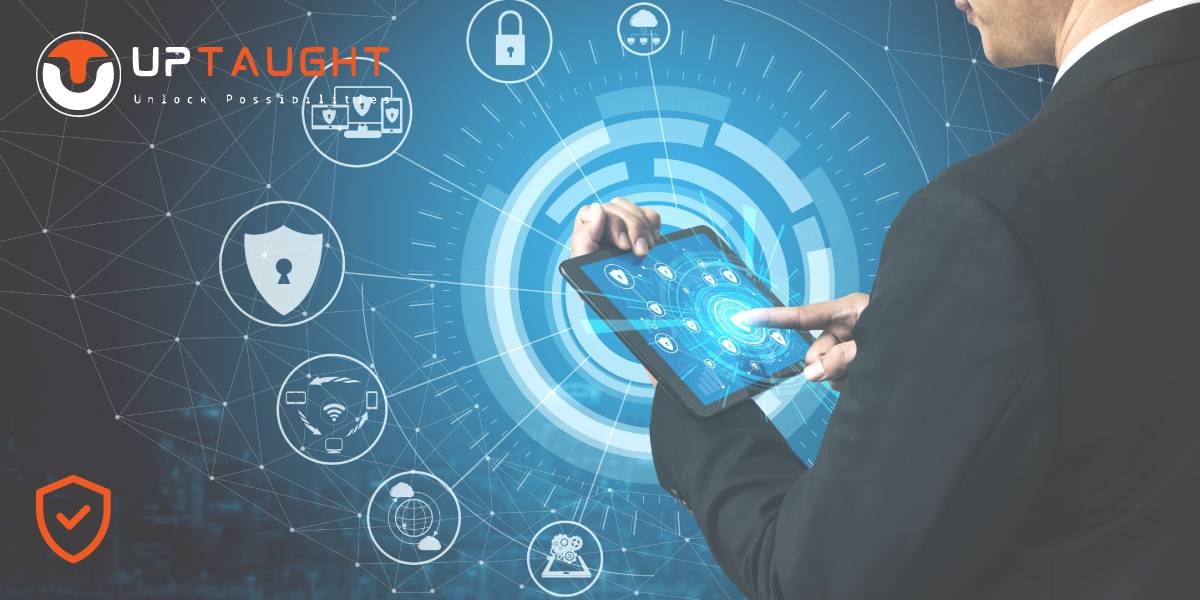Although the old education system of India has come a long way, Indian ed-tech startups are spending significant time and amount in strengthening their market share, getting considerable funding, and climbing up the popularity ladder fast.

UpTaught is an exciting platform for educators and learners of the 21st Century, where we provide various courses and opportunities to make education more advanced and personalized. At UpTaught, we share and showcase current and emerging technology learning models and identify strategic focus and development areas.
To begin, let’s start with the definition of cybersecurity.
Cybersecurity is a process of protecting confidential data from external and internal threats or unauthorized access. The fundamental purpose of cybersecurity is to protect the organization’s assets from disruptions caused due to natural catastrophes or cyber threats.
Table of Contents
Why is Cybersecurity so Important?
Nowadays, companies globally rely on technology, resulting in the surge of digital data creation. Today, governments and businesses maintain a significant deal of that data on computers and dispatch it across a network. We all know how vulnerable the devices and their underlying systems are, and when utilized, threaten the objectives of an establishment.
A data breach can have a range of overwhelming consequences for corporations. It can fathom a company’s reputation through the damage of customer and associate confidence. The loss of crucial data, like source files, can cost a company its competitive advantage. The data breach will also affect corporate revenues due to non-compliance with data protection ordinances. It’s estimated that, on average, a data breach can cost over crores for an affected organization. A high-profile data breach can make media headlines; hence organizations must embrace and implement a robust cybersecurity strategy.
Click here to Visit our Course page
The expenses of cybersecurity violations are on the rise? The organizations that suffer from cybersecurity breaches have to pay significant fines. Apart from paying fine, non-financial costs like reputational damage should be considered.
Cyber attacks are increasingly Complex? With intruders using an ever-expanding variety of approaches, cyber-attacks continue to evolve in sophistication.
Cybersecurity is a critical issue? Cybersecurity risk can oversight a challenge with new regulations and requirements. The management has to ensure that its cyber risk approaches will reduce the risk of attacks and restrict finance and operational impact.
Cybercrime is a booming business? According to a study, in 2018, the cybercrime marketplace was worth $1.5 trillion.


Types of Cybersecurity Hazards
Phishing: Phishing is the process of trying to collect personal information using unreliable emails or text messages. Phishing uses cloaked email/text as a weapon. The purpose here is to outwit the recipient into considering that the data is essential — for example, it could be information from their bank — and click a link or download an attachment.
Ransomware: Ransomware is a malware outbreak in which the cyber attacker secures and encrypts the victim’s data, crucial files and then demands a price to unhitch and decrypt the data. This type of attack accounts for human, system, network, and software vulnerabilities to affect the victim’s device.
Malware: Malware is the consolidated name for several malicious software alternatives, including viruses, ransomware, and spyware. The world has been under constant attack for years from thousands of diverse malware variants, causing the utmost damage possible.
Social Engineering: The art of manipulating users to give up their classified information is called Social engineering. The information cyber attackers are seeking from people can vary. Here, the cyber attackers target the individuals by tricking them into giving them their passwords, bank information, or access to the computer to install malicious software secretly. This will provide them with access to your passwords and bank details and control over your computer.

Cybersecurity is Growing Steadily:
Traditional cybersecurity is focused on the implementation of preventive measures around a designated perimeter. The latest enablement drives like remote working or Bring Your Own Device (BYOD) plans have dissolved the edge, limited discernibility into cyber activity, and extended the attack surface.
Nowadays, cyber violations are growing at a rapid pace despite record levels of security. Global corporations turn to human-centric cybersecurity, a new strategy that places focus on shifts in user behavior instead of an exponential number of increasing threats.
Established on behavior analytics, human-centric cybersecurity offers insight into how an end-user communicates with data and extends security checks into all the operations where data resides, even if not solely managed by the company. Ultimately, this approach is planned to recognize behavioral exceptions to surface and prioritize the most critical threats, diminishing investigation and threat detection.
Click here to Visit our Course page
Challenges of Cybersecurity:
Digitalization frequently influences all aspects of our lives and enterprises. We see accelerated adoption of artificial intelligence tools and an ever-widening dependency on software, hardware, and cloud infrastructure.
We know that companies worldwide communicate sensitive data across networks and other devices in doing business. The challenge here is to protect that information and the systems used to process or store it. As the volume of cyberattacks rises, organizations, primarily those tasked with safeguarding data relating to national security, health, or financial records, need to preserve their sensitive business and personnel information.
Cybersecurity is further classified into the following Sub-domains.
It involves executing various justifications within all software and services used within a company facing a wide array of threats.
Identity Management and Data Security
Identity management involves processes that allow authentication of authentic individuals to data systems within an establishment. Data security involves implementing robust information about its safety at rest and in transit.
Network security is all about implementing mechanisms to protect the network and infrastructure from unapproved access, interruptions, and misuse. It also protects enterprise assets against complicated threats.
Mobile security refers to protecting the company and personal data stored on multiple devices from several threats such as unapproved access, device theft or loss, malware, etc.
Cloud security is nothing but creating reliable cloud architectures and applications using various cloud service providers such as AWS, Google, Azure, Rackspace, etc., for an enterprise to assure security against multiple threats.
Disaster Recovery monitors, alerts, and plans to help organizations develop for administering business-critical systems during and after any disaster while resuming lost operations after an occurrence.
Training individuals about topics on network security is vital in increasing awareness about industry best practices, enterprise procedures, and monitoring and reporting malicious actions.
Businesses that embrace cybersecurity actively and enhance their cybersecurity infrastructure are more likely to be successful. The importance of cybersecurity will only grow in the future to take advantage of the agility, scale, adaptability, and resilience that digitalization guarantees.
Cybersecurity Market Growth & Trends
With the Covid pandemic on the rise, millions of professionals work remotely, creating significant opportunities for cyber hackers. It is time to end all the cyber attacks and take action to protect the organization.
The cybersecurity market globally is anticipated to expand its size favorably due to a boom in online attacks across networks and applications across various end-use sectors. As per the latest report, the Cybersecurity Market size is touted to touch USD 200 billion by 2025. It is expected to exhibit a 10.5% CAGR over the prediction period (2019-2025).
The COVID-19 pandemic has risen the spate of attacks as more users rely on the internet to meet their daily requirements. Online transactions and the unprotected state of payment gateways can drive the need for cybersecurity. The rise of hacking, phishing, and malware can increase the dependency on digital tools to boost cybersecurity demand. Furthermore, the launch of mobile applications for monitoring COVID-19 cases and the compromise of patients’ data have driven many governments’ need for exceptional security measures.
They primarily focus on every organization for their cyber risk management strategies by investing in technological frontline cyber defenses. As per the latest research, the global cybersecurity market by 2024 will be worth $300B.
Companies who lead their trades in cyber resilience deliver a more consistent quality of response while reducing the number of successful attacks. Also, over 70% of businesses have given training to their staff on how to remain cyber-safe during remote work, with specific training about validating passwords and log-in credentials.
Asia-Pacific is expected to have the most leading market growth for cybersecurity solutions over the estimated period. The strong presence of numerous market incumbents, coupled with current security threats in the sector, is anticipated to accelerate these solutions further.
Cyber Security Jobs & Salary
Cybersecurity jobs are exciting. This fast-paced field is perfect for anyone who loves the challenge of problem-solving. The demand for cybersecurity jobs will grow by 31 percent over the next few years.
With a significantly soaring demand for cybersecurity experts coupled with the lucrative salaries companies offer, a cybersecurity career is becoming one of the most sought-after profession options now.
Below are some of the cybersecurity jobs that are witnessing a considerable pay increase. The cybersecurity field comprises a wide array of jobs from entry-level to executive management and everything in between.
- Network Security Engineer
- Cyber Security Analyst
- Security Architect
- Cyber Security Manager
- Chief Information Security Officer (CISO)
- Ethical Hackers
The opportunity for cybersecurity careers is remarkably optimistic, making it an excellent option for anyone looking to enter this field. According to ISC2.org, there are almost 2.93 million cybersecurity positions open around the world.
With specialists projecting, cybercrimes will cost around $6 trillion annually by 2021; companies must recruit cybersecurity expertise to ensure they’re offering competitive salaries so they don’t miss out on the high-end talent.





